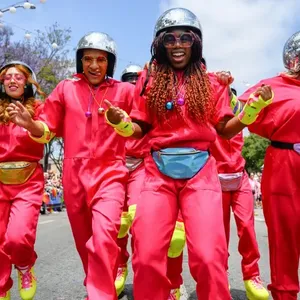One of my favorite Olympic sports is synchronized swimming.
I discovered the sport when, as a child, I stumbled upon the 1952 film Million Dollar Mermaid with Hollywood star Esther Williams.
Synchronized swimming (often abbreviated to synchro) was not Williams Olympic goal or sport of interest. She had hoped to compete as a swimmer in the 1940 Olympics, but they were cancelled because of World War II. Her aquatic talents were put to immediate use in Hollywood where her blockbuster films popularized the sport.
At the 1952 Olympics, the same year Million Dollar Mermaid hit theaters, synchronized swimming debuted. In 1984, it became an official Olympic sport.
From its showcase in 1952 to the present, Olympic synchronized swimming has been a female-dominated sport. Male synchronized swimmers, unfortunately, are barred from competing in the Olympics.
"There's still this same sort of old mindset. Oh well it's pretty, it's for girls," said team member of Out to Swim Ronan Daly. "But no, we want to challenge that and say boys can do this as well.”
But last month before the Olympics began, Out To Swim, a swim club in Britain with a male synchro team, wrote a letter to the International Olympic Committee and FINA, the international federation governing body of swimming, contesting that males deserve to compete in synchronized swimming, and their discriminatory rules need to be changed in time for the 2016 games in Rio de Janeiro.
"I think it's incredibly ironic that the Olympics are all about equality, yet we don't have a chance to compete, and other mens' teams don't have a chance to participate," said team captain Stephen Adshead of Out to Swim.
First known as "water ballet," synchronized swimming was thought of as a delicate, feminine and frivolous sport seen primarily as part of Hollywood musicals and Las Vegas acts that no real strong men would deign to engage in.
Case in point: Saturday Night Live’s well-known documentary-style spoof on male synchro in October 1984 featuring comedians Harry Shearer and Martin Short. "Shearer decided to parody the sport out of personal outrage that synchronized swimmers got the same Olympic medals as athletes in what he considered real sports," Tribune Olympic Sports writer Philip Hersh wrote.
Mocking the notion that a male would spend time pursuing the sport, Shearer, in the skit, portrays a man giving up his job in pursuit of being the first male synchronized swimmer in the Olympics. Shearer and Short, wearing swim caps, lifejackets and nose plugs, do a silly interpretive dance in the shallow end of the pool that helped foster a damaging image of the sport as purely entertainment rather than athleticism.
More on next page...
\\\
(continued)
"Men have never done synchronized swimming in a sanctioned competition in this country. Officially, it's got like a zero acceptance rate... Men's synchro isn't even in the '88 Olympics yet," acknowledges one character.
"That's okay, because we could use the time," he then spoofs. "'Cause I'm not... I'm not that strong a swimmer.”
But for those males and females who do synchro they know of the rigor, precision and pain of the sport.
Synchronized swimming is a combo of swimming, dance and gymnastics. It’s performed in deep water and accompanied by music requiring core strength, stamina, flexibility, breath control, and coordination, to name a few. The sport consists of several competitive formats: solo, duo, trio and team routines. Training can be easily six days a week from six to seven hours a day in the pool and then two to three hours out of it.
"The toe point. Try it—it's not easy. Point your foot and then try to bend all your toes like a fist. To get that we train out of the water, too. When watching TV or just sitting around the house, we have these things called ‘toe bands'... its like Chinese foot binding,” Patrick Cain wrote in Secrets of Synchronized Swimming.
In its very early days, synchro was exclusively a male-dominated sport. However, because of its perceived feminine physical movements, synchronized swimming was deemed a more suitable and expectable activity for females only.
While the gender bias in the sport is resoundingly blatant, the homophobic aspect may not be. But male synchronized swimming is primarily associated with homosexuality.
Case in point: the 2001 wildly popular Japanese comedy Waterboys. Written and directed by Shinobu Yaguchi, Waterboys depicts five male high schoolers that become Japan's first male synchronized swimming team. The youngest member of the team is gay. The team is jeered by fellow classmates, and its only support comes from the local drag queens.
With the sport having both a gender bias and being homophobic, gay coaches like Don Squire and his partner Del Neel of Cyprus Club in Carmel Valley struggle to be taken seriously as competitors. "Two gay men coaching in a women's sport is just not that politically popular with U.S. Synchro.”
Whenever discrimination is the culprit for barring great athletes from competing in the Olympics, it is not only the athletes who miss out, but so, too, the world.
Californian Kenyon Smith is one of best synchronized swimmers in the world, but many of us will never know. He was barred from entering the 2008 Beijing Olympics. And he's not in this year's game.
And, in case you're wondering, Smith is heterosexual.
Follow SheWired on Twitter!
Follow SheWired on Facebook!


























































































































